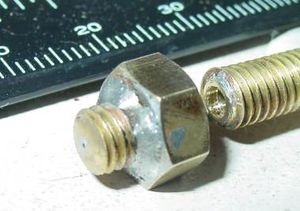InterchangeableNozzleMk2
To make the Mk 2 Extruder nozzle interchangeable, just drill the 3mm central hole right through the brass M6 bolt normally used for the body of the nozzle.
- The detatchable nozzle concept. This one has been reduced in diameter with solder around a piece of nichrome wire, which is then removed to leave the vital hole. It has not yet been tapered.
Take a threaded section of M6 brass - a bolt offcut or somesuch at least 20mm long for ease of handling - and drill a 3mm hole into it about 4mm to 5mm without wrecking the thread. Tidy the face up if needed. You will also need a brass M6 nut of a minimum 5mm thick; if the nut is much thicker, you'll need a deeper 3mm hole in the threaded section. Then drill another millimetre down using a 2mm drill bit.
Drill your nozzle's hole into the bottom of this hole, going in 1.5mm-2mm. As the drill bit does not emerge from the other side of the rod yet, it should be less prone to breaking fine drill bits off - I hate it when that happens.
Now, probe the depth of the 2mm hole. Add on a millimetre, and mark that as the edge of where you'll cut the threaded rod, and take it off with a hacksaw or grinder - don't try tidying the cut just yet. Screw the rod into that M6 nut about 1/3 the way down it leaving the little hole and untidy sawn-off end pointing out, and solder the rod into the nut without flooding the remaining thread. Use a big soldering iron, or preheat the assembly with a torch, then touch up with a small soldering iron. Do not heat and apply solder at the same time with a torch, or you'll melt the incoming solder before it gets to the workpiece.
With the nut clamped firmly in a vice, use a file to take off any exposed thread. If the exit hole is off-centre, now is the time to hack away excess brass so that the hole appears to be in the centre of your nozzle. Even nozzles that are desperately off-centre can be rehabilitated this way- trust me! Then use the file to put a 45 degree taper all the way around, forming a cone with the exit hole at the apex. You'll find it easier to rotate the workpiece than file away from weird angles. You're aiming to have an apex that is less than 1mm across, with the exit hole in the centre. DO NOT file across the hole; shape the cone around it. When all is shaped, smooth things off with fine carbide paper to make the removal of excess polymer easier.
Now attack the nozzle from the rear with one of those routing tools that looks like the business end of an old-fashioned lemon-squeezer to make the inside of the hole taper towards the exit. Stop grinding when the tip of the tool reaches the nozzle's exit hole. Pause frequently to keep the hole lean, clearing it with the fine wire - do not use a pin or you'll enlarge the hole. When done, there must be no debris of any kind left over in the nozzle, or the thing will clog. After checking the nozzle itself is clear one last time, scrub off any excess flux and screw the assembly onto the end of your Mk 2 extruder.
I liked this method because I am a lazy beggar and found with a little practice I could make one quite passably without having to set up the lathe.
If polymer leaks out of the thread where the nozzle attaches to the heated extruder barrel, cut a thin washer from suitably-sized silicone rubber tubing and sandwich it between the nozzle and the extruder barrel.
-- Main.VikOlliver - 16 Jul 2006
